Erika Mailman's Blog, page 18
January 15, 2013
Package for Indiana Jones
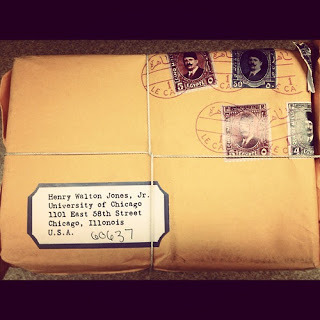 I'm coming to this late and some of you may have already seen this...
I'm coming to this late and some of you may have already seen this...Someone sent a package to the University of Chicago addressed to Henry Walton Jones, Jr. The label is typed and of a vintage style (rectangular, with trimmed edges, limned in black), and the stamps and postmarks are from Egypt. The handwritten zip code doesn't appear to be vintage handwriting (and zip codes wouldn't have existed at the time this package would have been sent to Indy--1917 or so)
Henry Walton Jones, Jr. is of course Indiana Jones, and now the U of C is trying to figure out who sent the package, full of goodies like Abner Ravenwood's dusty diary with narratives like discovery of the Staff of Ra and what the Holy Grail might be made of, and photographs of Marion Ravenwood.
Here's the university's announcement of the wonderful, strange package. The school asks, "If you’re an applicant and sent this to us: Why? How? Did you make it? Why so awesome?"
. . . .
Published on January 15, 2013 00:11
January 9, 2013
Sacramento Train Museum...and its Oakland lamp
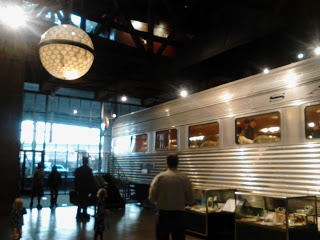 Long before Thomas the Tank Engine entered my life, I experienced an attraction to the railroad. In high school I had a gorgeous Art Deco poster of a Wagons Lit poster on my wall, and I've always thought longingly of what it would be like to travel in the golden days of rail.
Long before Thomas the Tank Engine entered my life, I experienced an attraction to the railroad. In high school I had a gorgeous Art Deco poster of a Wagons Lit poster on my wall, and I've always thought longingly of what it would be like to travel in the golden days of rail.The Sacramento Railroad Museum shows amazing examples of cars, engines, and even....the element I most remember from my first trip a decade ago....the china and flatware used on various trains. An entire dining car is set for a meal with each seat showcasing the place setting of a different line throughout the U.S.
We visited again in December, and the car that is "dressed" for night, with windows blackened and occasional lights flashing, that rocks as if you are underway, was a real thrill for the younger set that accompanied me. In fact, I think we went through that train at least ten times. There's even a fellow (mannequin) sleeping in the lower bunk bed in the last car.
And right outside it, I noted a gorgeous dome lamp hanging from the ceiling: enormous, municipal and simply ravishing. And it turns out it is from the 16th Street station in Oakland, one of three chandeliers that once hung there. The station was damaged in the 1989 earthquake and I believe was recently restored and used in several movies as it is a truly grand example of a light, airy aesthetic station.

 Although it's hard to tell in the photo, the lamp's glass looks like mother of pearl, and indeed a plaque at the museum notes that it was created at the Kokomo Opalesescent Glass Company in Indiana in the early 1900s. I love finding Oakland reminders, and this was a lovely one.
Although it's hard to tell in the photo, the lamp's glass looks like mother of pearl, and indeed a plaque at the museum notes that it was created at the Kokomo Opalesescent Glass Company in Indiana in the early 1900s. I love finding Oakland reminders, and this was a lovely one.. .. .
Published on January 09, 2013 20:58
January 1, 2013
Louis XVI's blood in hollowed-out gourd
 It's strange to imagine that a man who so mightily ruled France might be reduced to the blotches on a handkerchief, dipped in his blood post-guillotining, and then stowed in a gourd kept by an Italian family for over 200 years--until it underwent DNA testing recently to be confirmed as his blood.
It's strange to imagine that a man who so mightily ruled France might be reduced to the blotches on a handkerchief, dipped in his blood post-guillotining, and then stowed in a gourd kept by an Italian family for over 200 years--until it underwent DNA testing recently to be confirmed as his blood.Here's the link to the BBC news article.
Accounts of the French Revolution reveal an appallingly blood-thirsty populace. Wow, just typing that made me go to the kitchen to pour a glass of wine. I'm not kidding.
But it's white wine, not red.
The squash was inscribed, "On January 21, Maximilien Bourdaloue dipped his handkerchief in the blood of Louis XVI after his decapitation."
I can't help but imagine the crush of people at the scaffold. How and why did Bourdaloue get close enough to dip his handkerchief? And what do you do afterwards: fold it up and put it in your pocket, or carry it aloft all day long as you sing revolutionary songs, waving it like a flag as its drops fly? Shudder.
I also looked at a Telegraph article which added a little more information, such that the handkerchief itself has long since decomposed and it was the bloodstained interior of the squash that was tested. The bloodstains were a close enough match to the DNA of what is believed to be the mummified head of Louis IV, an ancestor of the Sixteenth's, to call it conclusive.
Fascinating.
. . . .
Published on January 01, 2013 22:26
December 29, 2012
Having crushes on Victorians
 Have you ever had a crush on someone of the past? A daguerreotype that you couldn’t stop staring at?
Have you ever had a crush on someone of the past? A daguerreotype that you couldn’t stop staring at?A number of years ago there was an exhibit at the Oakland Museum of California called Silver and Gold: Cased Images of the California Gold Rush.
As I wandered around the exhibit, I found myself suddenly arrested by a group shot of men. There were maybe five men in the image, and one of them: well, he stared right out at me and I felt a jolt of recognition.
I don’t think I believe in reincarnation and yet I’m obsessed by the idea. I love the concept that you might encounter the same souls again and again in different incarnations. And if there is any truth to the idea, then for sure I was looking at someone I once knew.
The image isn’t online, but I just now realized there was an exhibition book that went along with the exhibit. I know what to put on my birthday wish list! I’d love to see him again…again.
* * * * *
I was reminded of this exhibit recently for a few reasons. One is that I wrote a gothic novel in which someone looks at a black and white photograph with a loupe and has a moment somewhat reminiscent of my experience.
The other--and the reason that I actually googled around and located the website for the 1998 exhibit at the Oakland Museum--is that I found this guy pictured above. And he gave me a similar sort of jolt--not necessarily the “I know you” jolt, but the “I would like to know you” jolt.
This is Charles Keeler circa 1895, an early Berkeley poet and a founding member of the Berkeley Hillside Club. I’ll blog more on this historic club later.
This photograph seems so contemporary to me, almost like it was staged to look Victorian. Charles isn’t necessarily my type, but something about his probing gaze is saying, “Let me set down my cheroot so I may better address my attentions to you.” I picture him saying all sorts of banal things but with an undercurrent of “I’m a gonna take your clothes off, layer by lacy layer, stripping off that shirtwaist and throwing your whalebone corset across the room.”
Charles: I’ve checked with my husband and timetravel hooking up isn’t really cheating. I’ll meet you in 1896, okay? New Year’s Day? Right by the oak tree in the Oakland City Hall plaza?
. . . . .
Published on December 29, 2012 14:51
December 28, 2012
Grief
 Novelists earn their keep by imagining themselves into other people’s circumstances. We professionally emote. We empathize by trade.
Novelists earn their keep by imagining themselves into other people’s circumstances. We professionally emote. We empathize by trade.Several weeks ago, I was in the middle of drafting a blog post, when I clicked over to another screen and learned the news about Newton, Connecticut.
I grieved for those parents and those children and those teachers with my entire body. Not just tears, not just sobs: entire back-breaking heaves that I only hoped could somehow ease something there, just a bit, somehow. If I took on one woman’s pain, just one tiny atom of its immense and universe-sized volume, I hope I helped her.
Their world was altered in mere minutes and they will spend lifetimes trying to return to the moments before that man entered the schoolyard with his assault guns. They will never succeed.
My love and my grief to you, town of unspeakable misery.
Poem for Newtown, Connecticut
A dimple
that is what they can remember
maybe it will be her cowlick
or her arm really at the wrong angle
to write correctly, coming down
to the paper, not up to it. That report card.
She was supposed to improve
her sloppy handwriting but they didn’t
get around to it yet.
She was wearing spirit wear.
Her room is still messy.
She had that light husky cough.
They talked of keeping her home.
They can’t really remember those
who passed, elderly parents and neighbors,
without photographs. And so it will be
with her.
It will someday be impossible
to conjure up exactly how she was.
They will study
the worksheets and the papers
with their dotted lines inside solid lines
like a road, really, an escape route
that showed her how to correctly form
her letters. They will scrutinize
the drawings: mermaids with wings,
fairies with crowns, beetles crawling
the margins. They are going to try
very, very hard to retain her.
They are going to fail.
She was brevity itself.
She is already unsnatchable
from the air, a vapour,
a hint of something dear,
something so wrenched
from their very blood,
their breath,
the threads of their meat,
the throb of their pulse,
the water that still
rocks inside them,
like they are oceans set
askew, tilted.
They will comb the air
for her, they will claw
the air, they will scry
the air for her,
they will look
and look and look
and look and look
and look
and
. . . .
Published on December 28, 2012 15:50
December 9, 2012
Nanowrimo 2012
Now that I’m (slowly) coming out of my sleep deficit for Nanowrimo, I wanted to post about my inaugural experience with it.
Nanowrimo is short for National Novel Writing Month, and it’s an initiative invented by Chris Baty, a wacky Berkeley guy. When I interviewed him for Oakland Magazine, he said, among many witty things, “In every group of friends, there’s someone who says, ‘Let’s dress up like donkeys and go down Market Street.’ I’m that guy.” After that, I knew I had to participate in Nanowrimo myself.
In essence, each November 1, thousands of people around the world drop everything and try to write a novel—well, at least 50,000 words—by Nov. 30.
There’s a supportive, cheerful website that fuels the whole endeavour, www.nanowrimo.org. You sign up for free, and once the month begins, you are able to update your word count (obsessively, in my case) in a display next to your name/photo. Your page includes a bar graph showing your progress and the expected progress, and your statistics show you the date you can expect to finish if you continue at the same rate. You can add buddies and track their progress too. You can attend local write-ins, where you meet up with other nanos and write together; I went to one with a group that wanted to talk rather than write, but I really liked the concept anyway. At the end of the month, you cut and paste your novel into a little text box, and within seconds your word count is verified and you’re announced a “winner.”
If you hit 50K words, that is.
And it’s….really….just not that….easy.
To hit 50K words in 30 days, you must write 1,667 words per day. That’s about six double-spaced pages. For me, six pages represents not just a good writing day, but a great writing day. And therefore, during November, you must have a great writing day every day. That’s hard.
Right away, I felt overwhelmed. By Day One, I was already behind. By Day Two, I was thousands of words behind. By Day Three, I thought, “I might not be able to do this.”
On either Day Four or Five, I invested in myself. I parked the children at a drop-in daycare center and hied myself to a café. There I worked for 1.5 hours, writing steadily, then walked down the length of the little strip mall to a taqueria, where I spent the next 1.5 hours, again writing steadily. In three hours, I wrote 5,000 words. That was enough to almost catch me up. Not quite, but enough to feel like I was in the running again.
My month continued like that. Days where my word count was abysmal, and then days when I would write hell for leather and almost catch up. “Almost” being the key word. I kept watching that darn diagonal line in my bar graph and trying to reach it.
I came up with a few strategies to up my word count:1. If your sentences are excessively wordy, great! Don’t fix them. Plenty of time to do that on Draft 2. Just let them stand. Every word counts in Nanowrimo.
2. Find some kind of gimmick to up the word count. My novel is set in Ireland so I hit on the idea of including characters from some of the fantastic Irish ballads. Nancy Spain? Why yes, there she is on page 125, trying to hawk her ring. The Star of the County Down? That pretty lady appears too.
3. Try writing from another character’s point of view. All along, my novel was written first person. When I decided to write a few scenes from another character in third person, suddenly pages came pouring out of me, and I had a couple of 2K word days. I think those scenes enrich the book and they’ll stay.
By the last week of Nano, I was exuberant. I knew I could make it. I had to stay up to midnight to do it (my target bedtime is 9:30, wild life, right?) and I’m still reeling from that. But it was worth it. It was just one month out of the year, and I threw myself into a project with a zeal that has previously only come from doing writing retreats where I was by myself and someone else fed, sheltered and studio’d me.
Nanowrimo will certainly humble you if you can’t make space in your life to achieve that “ridiculous” (Chris Baty’s word) word count. A good friend’s father went into the hospital this November and she had to suspend her nano writing or I know she would have made it (yes, he’s fine!). It’s fun, zany, serious, debilitating, exhilarating, all-consuming. Thanks, Chris Baty, for a fantastic month.
What about you? Are you on board for next year?
. . . . . .
Published on December 09, 2012 21:08
December 8, 2012
Literary Joke
. . . The other day I was looking at a list of donors for a local school’s funding drive, and on one line by itself was this donor:
Magwitch.
I laughed with delight. I love finding literary jokes hidden in the real world. Magwitch of course is the character in Great Expectations who is a secret donor funding Pip’s education, although Pip believes it is Miss Havisham (sorry for the plot spoiler, but the book is 200 years old!)
I wish I’d thought of it.
Anyone have any literary jokes they’ve come across over the years?

Magwitch.
I laughed with delight. I love finding literary jokes hidden in the real world. Magwitch of course is the character in Great Expectations who is a secret donor funding Pip’s education, although Pip believes it is Miss Havisham (sorry for the plot spoiler, but the book is 200 years old!)
I wish I’d thought of it.
Anyone have any literary jokes they’ve come across over the years?
Published on December 08, 2012 22:44
November 15, 2012
Historical Novel Society conference
The Historical Novel Society conference takes place June 21-23 at St. Petersburgh, Florida. I'm excited to report I'll be participating in a panel titled "The Witchcraft Window: Scrying the Past." This panel will talk about witchcraft in fiction, and features Kathleen Kent (The Heretic's Daughter), Mary Sharratt (Daughters of the Witching Hill), Suzy Witten (The Afflicted Girls) and me (The Witch's Trinity).
Each of us has a slightly different take on witchcraft and already via emails we've had some thought-provoking conversations, so I think this will be an interesting panel. Some of us believe in witchcraft; some of us don't. Some of us see it as a feminist issue; some of us don't. Some of us descend from women accused of witchcraft; some of us don't. Come to find out which is witch....er, which!
Kathleen and Suzy's books look at the Salem hysteria, Mary's book is about the Pendle Witch trials in England in 1612, and my book is a fictional account of a woman accused in Germany in the early 1500s.
The link to the conference is here. It's for both readers and writers--and agents and editors will be there too. I attended in 2011 and met fantastic people, one of which is now a very close friend. It's a fun time to get together with people who love history and love reading: a powerful combination.
. . . .
Each of us has a slightly different take on witchcraft and already via emails we've had some thought-provoking conversations, so I think this will be an interesting panel. Some of us believe in witchcraft; some of us don't. Some of us see it as a feminist issue; some of us don't. Some of us descend from women accused of witchcraft; some of us don't. Come to find out which is witch....er, which!
Kathleen and Suzy's books look at the Salem hysteria, Mary's book is about the Pendle Witch trials in England in 1612, and my book is a fictional account of a woman accused in Germany in the early 1500s.
The link to the conference is here. It's for both readers and writers--and agents and editors will be there too. I attended in 2011 and met fantastic people, one of which is now a very close friend. It's a fun time to get together with people who love history and love reading: a powerful combination.
. . . .
Published on November 15, 2012 09:01
October 20, 2012
Artwork based on Timberline photo
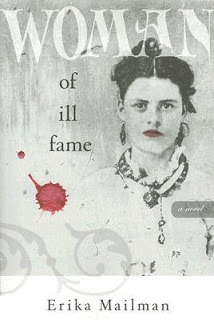 It' s been amazing how many little bits and drabs of information file in sporadically on the woman known as "Timberline," the Dodge City prostitute whose image adorns the book jacket of my novel Woman of Ill Fame.
It' s been amazing how many little bits and drabs of information file in sporadically on the woman known as "Timberline," the Dodge City prostitute whose image adorns the book jacket of my novel Woman of Ill Fame.When I asked Heyday Books to use her photograph for the book jacket, all I knew about her was what I just typed in the previous paragraph.
Over time, readers have contacted me with different little tidbits to add and/or directed me to other references that source her. That was how I learned her real name was Rose Vastine, and that she had tried to kill herself: both facts that I found shocking. She does not look like a Rose to me! And I was very upset to learn that such a strong-looking woman had succumbed to such despair. I learned that Timberline was her nickname because she was over six feet tall.
Recently someone named David Huerbin contacted me to let me know her full name was Rosanna (again: surprise!) and that her nickname arose because she would ferry whiskey and girls to men living in the mountains above the timberline. That seems more plausible to me. She somehow just doesn't look six foot in her image, and given that people were even less tall in the 1800s than today, I just found the other explanation hard to swallow.
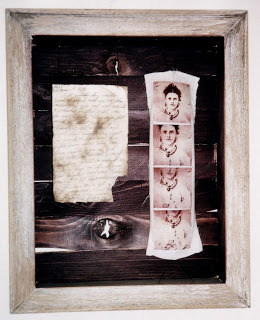 Just like me, this person was intrigued by her image and in fact has created a piece of art based on her. With his permission, I am attaching it here. The letter next to her image is a "suicide letter" he created for her. This piece was showcased in The Basement Gallery in Flagstaff, Arizona in 2002. More later.
Just like me, this person was intrigued by her image and in fact has created a piece of art based on her. With his permission, I am attaching it here. The letter next to her image is a "suicide letter" he created for her. This piece was showcased in The Basement Gallery in Flagstaff, Arizona in 2002. More later.. . . . .
Published on October 20, 2012 18:33
September 15, 2012
The A/C Ratio and being thin as a playing card
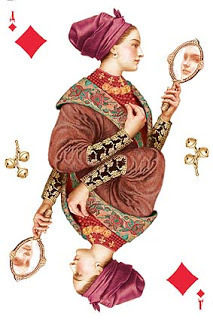 I think I first heard this phrase from a buddy in my old writers group, author Kemble Scott.
I think I first heard this phrase from a buddy in my old writers group, author Kemble Scott.The A/C Ratio is terribly important for writers. It is a part of everything they do. It's integral to productive work days.
A = Ass. And C=Chair.
It's monumental. It's cataclysmic. One has to actually SIT DOWN to write.
Sure, you can dictate while you breeze through your workout. You can certainly come up with devastatingly clever dialogue while standing talking to someone who is boring you. But at the end of the day, at some point: yes, you must sit.
I love this bit from Stephen Koch's The Modern Library's Writer's Workshop.
And you must sit down and write. It doesn't even really matter if you feel like writing. As Tom Wolfe says, "Sometimes, if things are going badly, I will force myself to write a page in half an hour. I find that can be done. I find that what I write when I force myself is generally just as good as what I write when I'm feeling inspired."....Joyce Carole Oates agrees: "One must be pitiless about this matter of 'mood.' In a sense, the writing will create the mood....I have forced myself to begin writing when I've been utterly exhausted, when I've felt my soul as thin as a playing card, when nothing has seemed worth enduring for another five minutes...and somehow the activity of writing changes everything."
Let's see if we can all improve our A/C Ratios in the upcoming weeks. I know I'm working on it.
. . .
Published on September 15, 2012 17:20



